A
Auto Express
Guest
Much of what happens in global car culture originates in the US, and wrapping cars in vinyl is no exception. You need to go all the way back to the 1950s for the origins of vinyl wraps, when a company in the US offered polka dot treatments you could stick on your car yourself to mimic contemporary clothing fashions.
The use of vinyl stickers for graphics and logos became extremely widespread, but the practice of covering a whole car in vinyl didn’t really take off until the 1990s. That’s when somebody twigged that German taxi fleet owners could save a fortune by wrapping their taxis instead of painting them.
German law demanded taxis should be a particularly horrid shade of beige, which meant nobody wanted to buy a second-hand one unless it was resprayed. Using a beige vinyl wrap meant taxi firms could order their new cars in more popular colours, with the added advantage of finding pristine paintwork when the beige wrap was peeled off after three years of taxi duty.
Once the cat was out of the bag the wrapping concept quickly took off. First of all corporate brands discovered the technique was perfect for turning vehicles quickly and easily into mobile billboards, and pretty soon vinyl wrapping was taken up by car enthusiasts around the world as a simple and relatively cheap alternative to changing the colour of your car with a respray.
Nowadays, vehicle wrapping is such big business that all sorts of new material and application technologies have been developed, some of which make it surprisingly easy for car owners to carry out a professional-looking DIY wrap job.
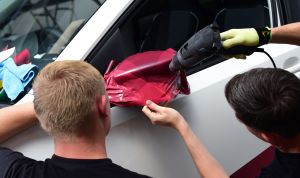
Vinyl wrapping process
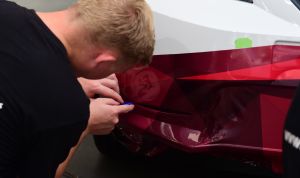
Vinyl wrapping process
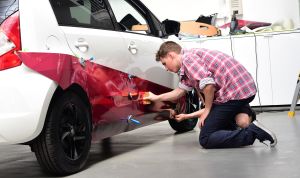
Vinyl wrapping process
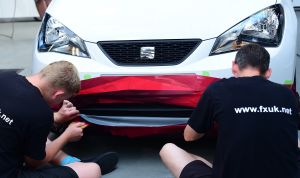
Vinyl wrapping process
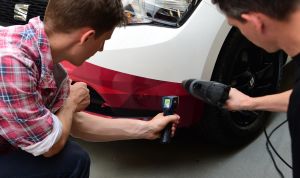
Vinyl wrapping process
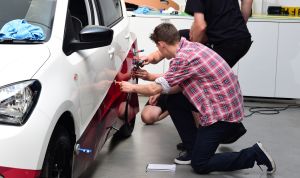
Vinyl wrapping process
The wrapping foils and films are where the biggest advances have come, with new vinyl types and adhesives that are more robust and effective, and an almost infinite availability of bespoke patterns, colours and finishes now available to drivers who want to customise their cars.
Finishes available today include matte, metallic, pearlescent or ‘flip-flop’-style finishes that change colour as the light moves, and some suppliers will happily print any design you care to present them with.
The material typically used for car wrapping today is known as cast vinyl, and it’s manufactured from a liquid that’s oven-processed to evaporate solvents leaving sheets of vinyl anywhere from 2-4mm thick. They’re designed to conform easily to curves and avoid shrinkage, and you should be able to expect a good quality wrap to last for anything up to 10 years if you look after it.
How do you apply a vinyl wrap?
Unlike spray-painting, which is a task that requires considerable skill and experience, the techniques involved in wrapping a car are much easier to get to grips with.
In fact, vinyl wrapping a car is arguably more of a ‘knack’ than a skilled trade, but professional outfits with years of experience of wrapping vinyl should offer the reassurance of a guaranteed good finish.
The principles are fairly simple but as usual, success is always reliant on good preparation – vinyl doesn’t like covering up chipped or scratched paintwork, and will often accentuate any underlying paint damage, which can also cause adhesion problems. A good finish also demands a keen eye and attention to detail while chasing out air bubbles and wrinkles, and here the professional outfits have the huge advantage of experience.

Vinyl wrapping process

Vinyl wrapping process

Vinyl wrapping process

Vinyl wrapping process

Vinyl wrapping process

Vinyl wrapping process
Assuming your car’s paint is in good condition, first it needs to be scrupulously cleaned and degreased with an agent such as isopropyl alcohol. Then it’s a case of laying vinyl sheets carefully across individual bodywork panels, squeegeeing out the air bubbles, trimming the edges and heating the vinyl gently with an airgun. This makes it cling tightly to the curves of the bodywork while activating the built-in adhesive.
It’s possible to work around trim such as door handles, mirrors and lights if you want a quick and easy finish, but reputable professionals will take the time to remove as many of these items as possible then refit after the wrap is completed.
It’s possible to wrap a car on your own, but more than one pair of hands makes the task much easier –especially when it comes to laying film out across larger panels and minimising troublesome air bubbles or wrinkles.
Wrapping versus a new paint job – the pros and cons
If you already have a new or pristine paint job, then wrapping your car to change its colour is an excellent choice. For starters you retain your own car’s originality and resale value, while simultaneously protecting its paint for several years to come. Meanwhile, you’re free to change its appearance as wildly – and as often - as you like, safe in the knowledge that your extrovert tastes in vinyl wraps can be peeled off to order, leaving no trace.
Attempting to personalise your car with a paint job requires a lot more commitment, because as well as affecting a car’s value, new paint takes much longer to prep and apply. Of course if your current paint job is tired, and you want to replace it with a desirable colour, then a new paint job could be a wise investment on a more expensive or collectible car. In those circumstances, covering up with a vinyl wrap may ultimately be money down the drain as future buyers will be more interested in what lies beneath the vinyl.
If you want a complex ‘custom’ design or finish, the cost of wrapping can begin to look much more competitive too, as replicating printed vinyl with a spraygun and specialist paint could take weeks of expert work and be horrendously expensive if you can’t do it yourself.
Longevity also needs to be a consideration, because although vinyl technology has advanced sufficiently to ensure a well-looked after wrap can last for many years, it’s always going to be relatively temporary. An expensive paint job, on the other hand, could reasonably be expected to last indefinitely. This means it will always feel like the ‘pukka’ option for many car enthusiasts.
How much does it cost to wrap a car professionally?
While it’s theoretically a simple task to wrap a car, it does require much more time than you might imagine to apply vinyl in a manner that’s effectively indistinguishable from a sprayed paint finish. The more time spent cleaning, painstakingly smoothing out films, trimming edges and ensuring good adhesion, the better the finished result will be. It’s also time-consuming to strip lights, badges and trim parts off a car so panels can be wrapped completely before those parts are replaced.

Vinyl wrapping process

Vinyl wrapping process

Vinyl wrapping process

Vinyl wrapping process

Vinyl wrapping process

Vinyl wrapping process
As a result, it can easily take two or three days for a professional wrap installer to turn a car around, and with two or more people working on an installation the costs quickly mount up.
While you’ll need to contact your chosen supplier for an accurate quote, we reckon you’ll be looking at £2,000-£2,500 for a full professional body wrap on a hatchback such as a VW Golf, while you could add an extra £500 or so for a larger car such as BMW 3 Series.
How easy is it to DIY wrap a car?
While most people assume wrapping a car as a cost-effective means of changing the body colour, it can still seem surprisingly expensive once you look into it. If the costs of getting it done professionally are prohibitive, then the obvious alternative is a DIY wrap.
If you just want a quick and easy finish that looks good from 10 metres away, then the average DIYer is probably sufficiently competent to take the job on. However if you want a finish that’s as good as the professionals, you’re going to have to be prepared to spend many hours on the task. Be warned too, that it can be extremely frustrating for those without the patience, manual dexterity or attention to detail that comes with experience.
You can save yourself a packet on labour, but the raw material isn’t exactly cheap. A 1.5m x 16m roll which should be enough to cover a VW Golf will likely cost £250 to £300. You won’t need many tools though, and there are plenty of tutorials on YouTube if you want to get stuck in.
Not convinced by vinyl car wrapping? Read our guide to car paint protection...
Continue reading...
The use of vinyl stickers for graphics and logos became extremely widespread, but the practice of covering a whole car in vinyl didn’t really take off until the 1990s. That’s when somebody twigged that German taxi fleet owners could save a fortune by wrapping their taxis instead of painting them.
German law demanded taxis should be a particularly horrid shade of beige, which meant nobody wanted to buy a second-hand one unless it was resprayed. Using a beige vinyl wrap meant taxi firms could order their new cars in more popular colours, with the added advantage of finding pristine paintwork when the beige wrap was peeled off after three years of taxi duty.
Once the cat was out of the bag the wrapping concept quickly took off. First of all corporate brands discovered the technique was perfect for turning vehicles quickly and easily into mobile billboards, and pretty soon vinyl wrapping was taken up by car enthusiasts around the world as a simple and relatively cheap alternative to changing the colour of your car with a respray.
Nowadays, vehicle wrapping is such big business that all sorts of new material and application technologies have been developed, some of which make it surprisingly easy for car owners to carry out a professional-looking DIY wrap job.

Vinyl wrapping process

Vinyl wrapping process

Vinyl wrapping process

Vinyl wrapping process

Vinyl wrapping process

Vinyl wrapping process
The wrapping foils and films are where the biggest advances have come, with new vinyl types and adhesives that are more robust and effective, and an almost infinite availability of bespoke patterns, colours and finishes now available to drivers who want to customise their cars.
Finishes available today include matte, metallic, pearlescent or ‘flip-flop’-style finishes that change colour as the light moves, and some suppliers will happily print any design you care to present them with.
The material typically used for car wrapping today is known as cast vinyl, and it’s manufactured from a liquid that’s oven-processed to evaporate solvents leaving sheets of vinyl anywhere from 2-4mm thick. They’re designed to conform easily to curves and avoid shrinkage, and you should be able to expect a good quality wrap to last for anything up to 10 years if you look after it.
How do you apply a vinyl wrap?
Unlike spray-painting, which is a task that requires considerable skill and experience, the techniques involved in wrapping a car are much easier to get to grips with.
In fact, vinyl wrapping a car is arguably more of a ‘knack’ than a skilled trade, but professional outfits with years of experience of wrapping vinyl should offer the reassurance of a guaranteed good finish.
The principles are fairly simple but as usual, success is always reliant on good preparation – vinyl doesn’t like covering up chipped or scratched paintwork, and will often accentuate any underlying paint damage, which can also cause adhesion problems. A good finish also demands a keen eye and attention to detail while chasing out air bubbles and wrinkles, and here the professional outfits have the huge advantage of experience.

Vinyl wrapping process

Vinyl wrapping process

Vinyl wrapping process

Vinyl wrapping process

Vinyl wrapping process

Vinyl wrapping process
Assuming your car’s paint is in good condition, first it needs to be scrupulously cleaned and degreased with an agent such as isopropyl alcohol. Then it’s a case of laying vinyl sheets carefully across individual bodywork panels, squeegeeing out the air bubbles, trimming the edges and heating the vinyl gently with an airgun. This makes it cling tightly to the curves of the bodywork while activating the built-in adhesive.
It’s possible to work around trim such as door handles, mirrors and lights if you want a quick and easy finish, but reputable professionals will take the time to remove as many of these items as possible then refit after the wrap is completed.
It’s possible to wrap a car on your own, but more than one pair of hands makes the task much easier –especially when it comes to laying film out across larger panels and minimising troublesome air bubbles or wrinkles.
Wrapping versus a new paint job – the pros and cons
If you already have a new or pristine paint job, then wrapping your car to change its colour is an excellent choice. For starters you retain your own car’s originality and resale value, while simultaneously protecting its paint for several years to come. Meanwhile, you’re free to change its appearance as wildly – and as often - as you like, safe in the knowledge that your extrovert tastes in vinyl wraps can be peeled off to order, leaving no trace.
- SEE MORE How to remove car paint scratches
Attempting to personalise your car with a paint job requires a lot more commitment, because as well as affecting a car’s value, new paint takes much longer to prep and apply. Of course if your current paint job is tired, and you want to replace it with a desirable colour, then a new paint job could be a wise investment on a more expensive or collectible car. In those circumstances, covering up with a vinyl wrap may ultimately be money down the drain as future buyers will be more interested in what lies beneath the vinyl.
If you want a complex ‘custom’ design or finish, the cost of wrapping can begin to look much more competitive too, as replicating printed vinyl with a spraygun and specialist paint could take weeks of expert work and be horrendously expensive if you can’t do it yourself.
Longevity also needs to be a consideration, because although vinyl technology has advanced sufficiently to ensure a well-looked after wrap can last for many years, it’s always going to be relatively temporary. An expensive paint job, on the other hand, could reasonably be expected to last indefinitely. This means it will always feel like the ‘pukka’ option for many car enthusiasts.
How much does it cost to wrap a car professionally?
While it’s theoretically a simple task to wrap a car, it does require much more time than you might imagine to apply vinyl in a manner that’s effectively indistinguishable from a sprayed paint finish. The more time spent cleaning, painstakingly smoothing out films, trimming edges and ensuring good adhesion, the better the finished result will be. It’s also time-consuming to strip lights, badges and trim parts off a car so panels can be wrapped completely before those parts are replaced.

Vinyl wrapping process

Vinyl wrapping process

Vinyl wrapping process

Vinyl wrapping process

Vinyl wrapping process

Vinyl wrapping process
As a result, it can easily take two or three days for a professional wrap installer to turn a car around, and with two or more people working on an installation the costs quickly mount up.
While you’ll need to contact your chosen supplier for an accurate quote, we reckon you’ll be looking at £2,000-£2,500 for a full professional body wrap on a hatchback such as a VW Golf, while you could add an extra £500 or so for a larger car such as BMW 3 Series.
How easy is it to DIY wrap a car?
While most people assume wrapping a car as a cost-effective means of changing the body colour, it can still seem surprisingly expensive once you look into it. If the costs of getting it done professionally are prohibitive, then the obvious alternative is a DIY wrap.
If you just want a quick and easy finish that looks good from 10 metres away, then the average DIYer is probably sufficiently competent to take the job on. However if you want a finish that’s as good as the professionals, you’re going to have to be prepared to spend many hours on the task. Be warned too, that it can be extremely frustrating for those without the patience, manual dexterity or attention to detail that comes with experience.
You can save yourself a packet on labour, but the raw material isn’t exactly cheap. A 1.5m x 16m roll which should be enough to cover a VW Golf will likely cost £250 to £300. You won’t need many tools though, and there are plenty of tutorials on YouTube if you want to get stuck in.
Not convinced by vinyl car wrapping? Read our guide to car paint protection...
Continue reading...
